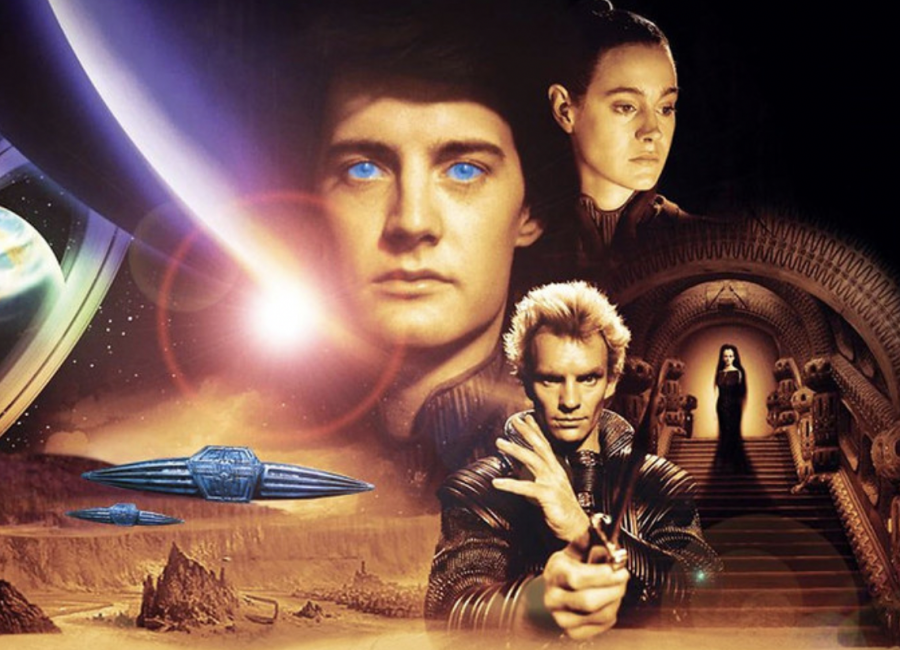Opinion: “Dune” lived up to David Lynch’s version, and then some
Credit: Courtesy of Flickr user The Graphic Details
WSPN’s Genevieve Morrison compares the two versions of the Dune movie, which was created based on the classic sci-fi novel by Frank Herbert.
November 4, 2021
Warning: spoilers for “Dune” (1984 and 2021)
A harsh wind sweeps over vast dunes, stretching as far as the eye can see over the great expanse of the planet Arrakis. The fine powder, mixed with the precious, fragrant substance of spice, holds the key to the universe. One foreigner, Paul Atreides, appears as a tiny dot in the chasm of sand, the new leader of this unknown world. “Dune” has enamored both literary and cinematic audiences for decades. Does Denis Villeneuve’s new adaptation of this classic story live up to the hype?
Right off the bat, Lynch’s original version was your classic ’80s sci-fi movie, meaning it’s chock-full of horrible special effects and that trademark kitschy look. Its campiness has earned the film cult status, but it’s not held in high esteem by the critical community. On the other hand, the 2021 version is a full-blown $165 million Hollywood blockbuster, destined to be taken more seriously.
Villeneuve took a few key directorial liberties that made all the difference. The first was shortening the source material to just one part. The 600 page book by Frank Herbert was originally released in two parts, and adapting it into a 90 minute film is not a small task. The pure density of the source material caused issues for Lynch in his production. He originally pitched his film with a three-hour long runtime, but it was shut down by production executives. Ultimately, it made a big difference in the success of the film, considering it earned almost solely negative critical reviews, and to this day, holds a 44% rating on Rotten Tomatoes.
Villeneuve’s runtime, combined with a smaller amount of source material, gave him the freedom to delve into characters and develop them, which Lynch failed to do. For example, Duncan Idaho and Gurney Halleck are well-rounded characters in the 2021 version, where they had little screen time and development in the 1984 version. Duncan, played by Jason Momoa, provides an important aspect of comic relief that would have been completely absent otherwise. Additionally, his perspective as a warrior for House Atreides gives insight into those characters instead of just existing in the background.
Splitting “Dune” into two parts also allowed Villeneuve to zero in on specific elements of the story. By completely cutting out the second half of the story, he could focus on Paul’s rise to power and introduce the plight of the Fremen, the indigenous people of Dune. This also made the themes of the story more evident, ideas like colonialism and religion. The second half of the story concerns Paul’s reign as the Fremen messiah, which would have muddied the first half if included.
Lady Jessica, the protagonist’s mother, also serves as an important distinction between the two movies. A concubine for the Duke Leto Atreides, Jessica doesn’t hold the typical nuclear family wife role. However, it’s evident that the family holds a deep love for each other. At pivotal moments in the original movie, Francesca Annis’s Jessica could be seen crying for Leto, more concerned with her motherly duties than the conflict at hand. She passively observed the events of the movie, rather than participating in them. This portrayal could lead a viewer to believe that Jessica is a weak, unimportant character, which could not be farther from the truth.
Jessica is a member of a clan of powerful, clairvoyant, matriarchal witches called the Bene Gesserit. These women possess telepathic abilities and the power to control others with their voices. Contrary to the 1984 version, Rebecca Ferguson creates a solemn and stoic portrayal of the character, which adds a deeper layer to her personality. Ferguson’s Jessica seemed increasingly fearful of her son’s growing power as the Kwitsatz Haderach, or messiah. As a result, Jessica became a strong, well-rounded character that sparked the viewer’s interest. She was not just a figure in the background.
I’m a sucker for David Lynch’s weirdness, but combined with an already-convoluted plot like “Dune,” it resulted in a film conflicting with itself, an internal battle between Lynch and conservative production executives. It wasn’t necessarily confusing in the dreamlike way of “Mulholland Drive” or “Inland Empire.” To me, the confusion stemmed from the rushed plot, instead of an intentional directorial choice.
It goes without saying that the special effects were significantly better in the 2021 version. Lynch’s action shots and sci-fi elements largely came off as cartoony, lessening the overall suspense and thrill of the film. Additionally, the different portrayals of the various alien species were cultivated through Halloween-esque makeup and costuming, a far cry from the impressive CGI of Villeneuve’s version.
It’s abundantly clear that Villeneuve made an objectively better movie. However, to be fair, he had Lynch’s mistakes to learn from and the advantage of about 40 years worth of technological advancements to work with. Overall, the two directors took their own creative liberties to the story, but Frank Herbert’s brilliant world building and vision still shines through. Whichever one you prefer, the tale of Paul, the House Atreides and Dune will live on.





![Last Wednesday, the Wayland School Committee gathered to discuss a number of topics regarding the health curriculum and Innovation Career Pathway course. Another large topic of conversation was the ways to potentially mitigate distracting cell phone usage. "These [phones] are going to distract your learning and social relationships," Superintendent David Fleishman said. "That's concrete right there."](https://waylandstudentpress.com/wp-content/uploads/2025/06/Screenshot-2025-06-04-at-9.49.31 PM-1200x886.png)



























![Troy Hoyt finishes the Boston Marathon, running for the Hoyt Foundation. T. Hoyt is the son of Hoyt Foundation CEO Russ Hoyt.
“[Running a marathon] might seem like a big thing, when it’s presented to you at first, but if you break it up and just keep telling yourself, “Yes, you can,” you can start chipping away at it. And before you know it, you’ll be running the whole 26 miles, and you won’t even think twice about it.” T. Hoyt said.](https://waylandstudentpress.com/wp-content/uploads/2025/04/C36E8761-1CBB-452E-9DF2-543EF7B1095E_1_105_c.jpeg)













































